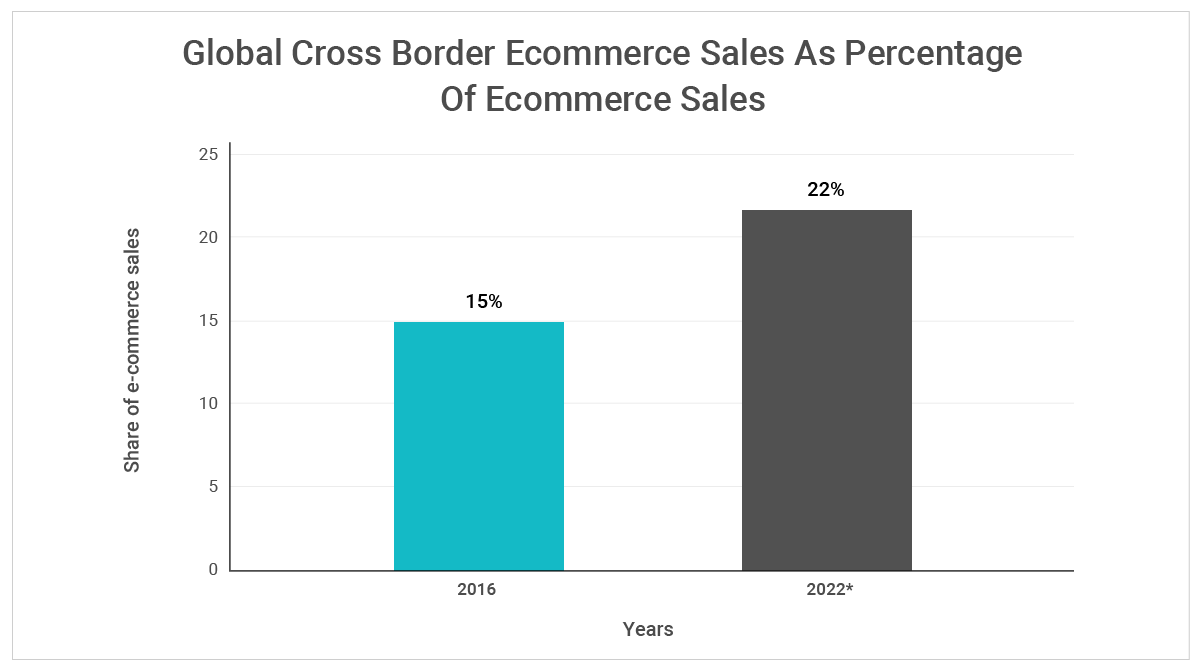Thinking to go global with your online business? Looking to make a name for your brand in international markets? Planning to win new markets with a variety of products and services!
A brilliant business strategy indeed!
And well-timed as well because ecommerce beyond borders is picking up like never before!!

(Source)
With ecommerce going beyond borders and customers open to explore new products at better prices, this is the right time to reach your buyers, wherever they are. All you need is the right products, good and timely shipping and a top ecommerce platform to help you manage your business.
Table of Contents
- The Latest Trends For International Ecommerce Selling
- Global Cross-border E-commerce Trends
- Benefits Of Cross-Border Ecommerce Selling
- Must-Have Features In The Top Ecommerce Platform For Global Businesses
- 5 Best Ecommerce Platforms For Global Businesses
- How To Choose The Top Ecommerce Platform For Your International Business
The Latest Trends For International Ecommerce Selling
According to industry forecasts cross-border e-commerce is estimated to reach $1 Trillion in 2020. In these times, customers want the best, and if you have the best to offer, why limit yourself to geographical boundaries?
The latest international ecommerce sales trends will give you all the more reason to go aggressive with your idea of expanding to new international markets.
Global Cross-border E-commerce Trends
- 35% of consumers buy on sites based outside their country, up from 26% in 2014
- 67% of global cross-border online buyers are buying because of lower prices outside of their own country
- Cross-border buyers are expected to grow from 361 million in 2015 to 943 million in 2020
- Cross-border B2C market was worth $304 billion in 2015 and is expected to reach $994 billion in 2020
Source: Invespcro
Selling internationally is a good business decision because it opens up new growth opportunities for your business. What’s more you can partner with a variety of local partners, sellers or distributors to reach new customers and become a popular business in new geographies.
Benefits Of Cross-Border Ecommerce Selling
When you go-global your business gains a competitive edge over others. Here are the advantages of taking your online business to international markets:
- Expand business internationally with customers in diverse countries that have better purchasing power and demand for your products.
- Boost sales by selling to a larger audience base across countries
- Make a name for your brand by creating brand awareness in different geographies
- Become your global customers favourite shopping hub by building a multilingual ecommerce site to sell internationally
- Sell unique products of local market at a more profitable price in international markets
- Improve business sustainability with customers and markets across diverse geo-locations
- Get better marketing ROI with targeted marketing for different user-groups
- Diversify business easily by doing partnerships with local merchants in different geographies.
With so many benefits, this business opportunity is worth exploring to create a niche for your brand.
Must-Have Features In The Top Ecommerce Platform For Global Businesses
Well, now that you have finally made up your mind about going beyond the borders, you need a powerful ecommerce platform that can support your business and help you grow your business.
Here is a list of features needed in your ecommerce software to help you tap global ecommerce markets:
- Support for multilingual ecommerce to connect better with your customers in their native language
- Ease of multi-currency payments to facilitate faster and transparent checkouts
- Ability to have themes in multiple languages to engage and convert your customers
- Host of international payment gateways to make checkouts frictionless
- Powerful tax engine to implement taxes according to a given country
- Inbuilt SEO and marketing solutions for applying different marketing strategies for different user groups
- Automated shipping solution with easy integrations with delivery partners of choice
Along with these your chosen ecommerce solution provider should also have features and tools needed to ease out the complexity of selling online. It should make your processes automated, error free and efficient.
5 Best Ecommerce Platforms For Global Businesses
Now that we understand the requirements of a top ecommerce platform for selling in international markets, let us check the pros and cons of the 5 best international ecommerce solution providers:
1. StoreHippo
StoreHippo comes with a host of go global ecommerce solutions for online businesses planning to opt for international selling. The best thing about the platform is that it offers inbuilt solutions for all your international selling needs along with a gamut of tools to run, manage and grow the business.
StoreHippo offers an inbuilt multilingual ecommerce solution along with support for multi-currency checkouts and invoicing. The themes can also be customized in multiple languages and there is support for RTL languages as well.
StoreHippo’s native solution does away with the need of buying multiple apps to implement multiple languages for international selling. Also, this makes the ecommerce portals fast and allows you to have 100+ languages without compromising site-speed. You also get better control of automatic and manual translation so you can implement or override one with the other for more nuanced and conversion oriented content.
You can even implement multilingual ecommerce features in your multiple storefronts, translate entities (like products, categories etc.) into multiple languages and customize buttons in the desired language. StoreHippo also allows you to auto-detect languages based on different IPs or set up different languages for different URLs and storefronts. You can even customize your store messages(error, warning, deals etc.) in multiple languages of your choice.
StoreHippo also offers multi-currency payment options wherein you can allow your customers to pay in the currency of their choice. The inbuilt powerful tax-engine engine lets you calculate various taxes based on the given country’s rules. You can also set up different taxes for different sellers on your online marketplace using the multi-level tax feature.
StoreHippo's go global ecommerce features also let you create multi currency invoices for your global customers. StoreHippo is integrated with 50+ international payment gateways that help you accept payments in almost all major currencies. The integrated shipping solutions help you add any shipping partner and set up shipping costs based on location, weight etc. in the currency of your choice.
Along with these, the SEO friendly top ecommerce platform also offers tools to optimize your site . It also has inbuilt marketing tools to help with international marketing.
To avail all these features you will have to opt for Premium, Business and Enterprise plans of StoreHippo. StoreHippo also allows you to customize your admin panel for multilingual ecommerce by adding the preferred native languages of your teams, vendors etc. However, you will have to pay for additional customization costs to do this.
2. Shopify
Shopify offers apps based solutions to run an international business with a multilingual ecommerce store. Shopify’s native multilingual solution is relatively new and only offers limited control to the admin to change languages. The customers cannot choose languages of their choice with this feature.
Shopify does have multiple apps to implement more than one language on your store. Some apps help with automatic translations while others are good for manual translations only. However, to completely turn your store into a multilingual website you might need 5-6 apps to make a fully-functional multilingual ecommerce store with themes and checkout in more than one languages.
Shopify also allows you to set up multiple currency payments for your stores. However, multi currency support is available only for Shopify stores and if you want to implement it in apps or POS you will need to make considerable changes and customizations through code. This makes the overall process cumbersome.
Also the subscription cost goes up quite high when you are using multiple apps. For multi-currency invoicing also, you will need apps that are paid on top of your subscription. Shopify marketing tools are also apps based so for your go global ecommerce solution with Shopify you would need a lot many apps.
Shopify users find managing these many apps a bit challenging as syncing these apps needs expertise with Shopify platform and its workarounds. The overall budget also inflates due to regular payment for these many apps.
3. Magento
Magento is one of the popular ecommerce platforms which comes with go global features. You can implement multiple languages and currencies on your Magento store to run an international ecommerce business. However, to implement the multilingual ecommerce solution you would have to add the specific extension for each language. To build a full-fledged site in multiple languages you will have to depend on multiple extensions, just like Shopify.
You can set up different currencies for your online store in Magento 2.0. You can also use different currencies on different storefronts in a multi-store set up. IP-based currency set up and currency rate update options are also available with Magneto.
However, to have a multilingual ecommerce store along with multi-currency set up, you will need to create a different store view in Magento 2.0. Also, a lot of fine-tuning and coding is involved to have a truly international online store set up that has multiple languages as well as currencies. This also requires changing product information in different languages manually. To automate this process you would need to pay for the extensions that make the task easier.
Although Magneto offers a better go global ecommerce solution than Shopify, to benefit from the features you would still need the expertise of a developer who is well-versed with the platform. There is a lot of online help and material available from the Magneto developer community, but exploring workarounds is a rather time-consuming process.
Some users have also complained that adding too many extensions makes the international sites slow and bug-prone. Paid extensions also tend to inflate your overall budget as you will have to keep adding more plugins for automating and streamlining the overall flow with multiple extensions.
Also to integrate the top international payment gateways with your go global Magento store, you would need extensions or the services of an experienced developer who can code a custom extension for your store. To integrate international shipping services you would have to buy extensions most of which are paid.
Along with these, the most bugging issue for Magento users is the upgrade every few years. This leaves no option but to go through painful migration to the new platform/version. This in itself means building your international Magento store all over again and finding and adding new extensions suitable for the new set-up. Magento is also known to have regular security issues which might be risky for large and complex set-ups.
4. BigCommerce
BigCommerce offers a host of go global features to build a store for international ecommerce. However, it does not have an inbuilt solution for creating a store in multiple languages. This can be done by creating multiple stores and customizing them to add one language of your choice in each store.
BigCommerce multi currency feature lets you add multiple currencies to your store and customize them to customize the display as per the local norms for the country. Bigcommerce also offers integration with international payment gateway, global shipping providers and taxation for multiple countries.
However, some BigCommerce features including some themes, checkout and storefront product filtering do not support the multi-currency feature. Also, as per the users of BigCommerce , the multilingual ecommerce feature is implemented partially and requires lots of customization and workaround to build a truly international ecommerce store.
BigCommerce is basically a developer oriented platform and to make the best use of the international ecommerce features you will need the services of a good developer who can understand the BigCommerce platform and implement desired changes for your international online store.
5. WooCommerce
WooCommerce also provides go global ecommerce features with the help of a number of plugins. You can add multiple languages and currencies to your store using the free and paid-plugins from WooCommerce.
WooCommerce also offers free and paid payment extensions for a number of international payment gateways. WooCommerce also has its own payments system but it is available only for merchants in the USA , accepting payments in USD. You can use WooCommerce shipping extension to set up global shipping for your international business.
Despite offering a number of free plugins, a major drawback with WooCommerce is that the free plugins are usually designed to do only a limited set of basic functionalities. For example, for free multilingual ecommerce plugins, you would need professional translators to do the manual translations. To automate the whole process you will need paid plugins which have different costs.
However, to build a feature-rich international store you would need a host of paid plugins. While this builds a good online store, on the flip side, having too many plugins slows the speed of your site. Another issue reported by WooCommerce customers is that implementing RTL themes in WooCommerce is quite a challenge.
Also, to make the best use of multiple third-party plugins you would have to connect with the developers of the given plugin so you can use all its features. Along with this you have to take care of hosting, upgrade and management for your international ecommerce store which makes the overall WooCommerce set up pricey.
How To Choose The Top Ecommerce Platform For Your International Business
Selling beyond broader gives the much needed exposure and growth opportunity to your business. However, to make the best of the situation, you will need the top ecommerce platform that is equipped with the best solutions for international ecommerce.
Apart from having the right features and tools your chosen solution provider should offer a smooth learning curve. The admin panel should be easy to use for your teams or sellers/distributors at various locations. The ecommerce software should make your life easy and help you handle your multilingual ecommerce business, with multi-currency settings easily.
Make an informed choice about your business by investigating the best ecommerce solutions listed above on their strengths and weaknesses. Start evaluating these platforms, book your free demo with StoreHippo right away!





















Leave a Reply